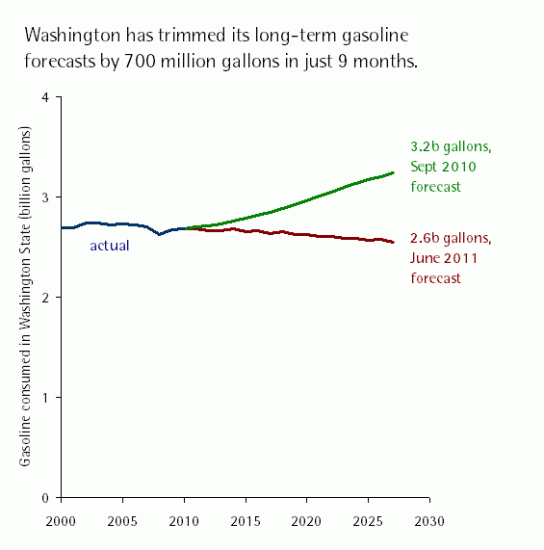I’m going to sound like Clark for moment. According to the most recent forecasts from Washington’s Office of Financial Management, drivers in the state will guzzle 2.6 billion gallons of gasoline in 2027. I have no idea if that’s accurate, but I do know that it’s 21 percent—and 700 million gallons—lower than the forecast that OFM made just 9 months previously.
My chart has the details:
That split between the lines amounts to a pretty shocking revision because it assumes that Washington has already hit peak gasoline consumption. In fact, according to the state’s official numbers the peak happened way back in 2002. For the foreseeable future the state’s experts now believe we’re looking at a long-term slide in gasoline use.
Now to be perfectly clear, I have no idea whether the red line is any more accurate than the old green line. No one really knows. But there is at least some reason to wonder whether even the latest forecast, published in June, may too be overshooting the mark.
The models used to produce these forecasts rely on a number of assumptions about demographics, economic growth, fuel prices, and so on. If those assumptions are off, then of course the forecasts can quickly get out of whack with reality.
Consider for example, that since the June 2011 forecast there have been plenty of new reasons be concerned about the condition of the economy. Add to that a new federal mandate to dramatically boost vehicle efficiency standards. Plus, OFM’s gasoline consumption forecasts rely on questionable assumptions about the price of fuel:
As you can see from their chart, above, OFM has been nudging up fuel price forecasts lately. Yet even the state’s current forecast assumes that retail gasoline prices will reach only to a high point of $4.76 per gallon in 2022, after which they will apparently decline a bit. If actual prices go higher than forecast—whether the cause is global oil markets or higher state gas taxes—then we should expect lower levels of consumption.
Now, again, I don’t know whether OFM’s fuel price forecasts are right or not. (They’re based in large part on data from the US Energy Information and Global Insight.) What I do know is that forecasting is a notoriously tricky business, and that there’s much uncertainty ahead. To me, uncertainty argues strongly for caution with respect to transportation expenditures. If we believe our future transportation revenues are constrained—and perhaps severely constrained—then it probably makes more sense to invest in low-cost flexible solutions rather than in large costly projects.









